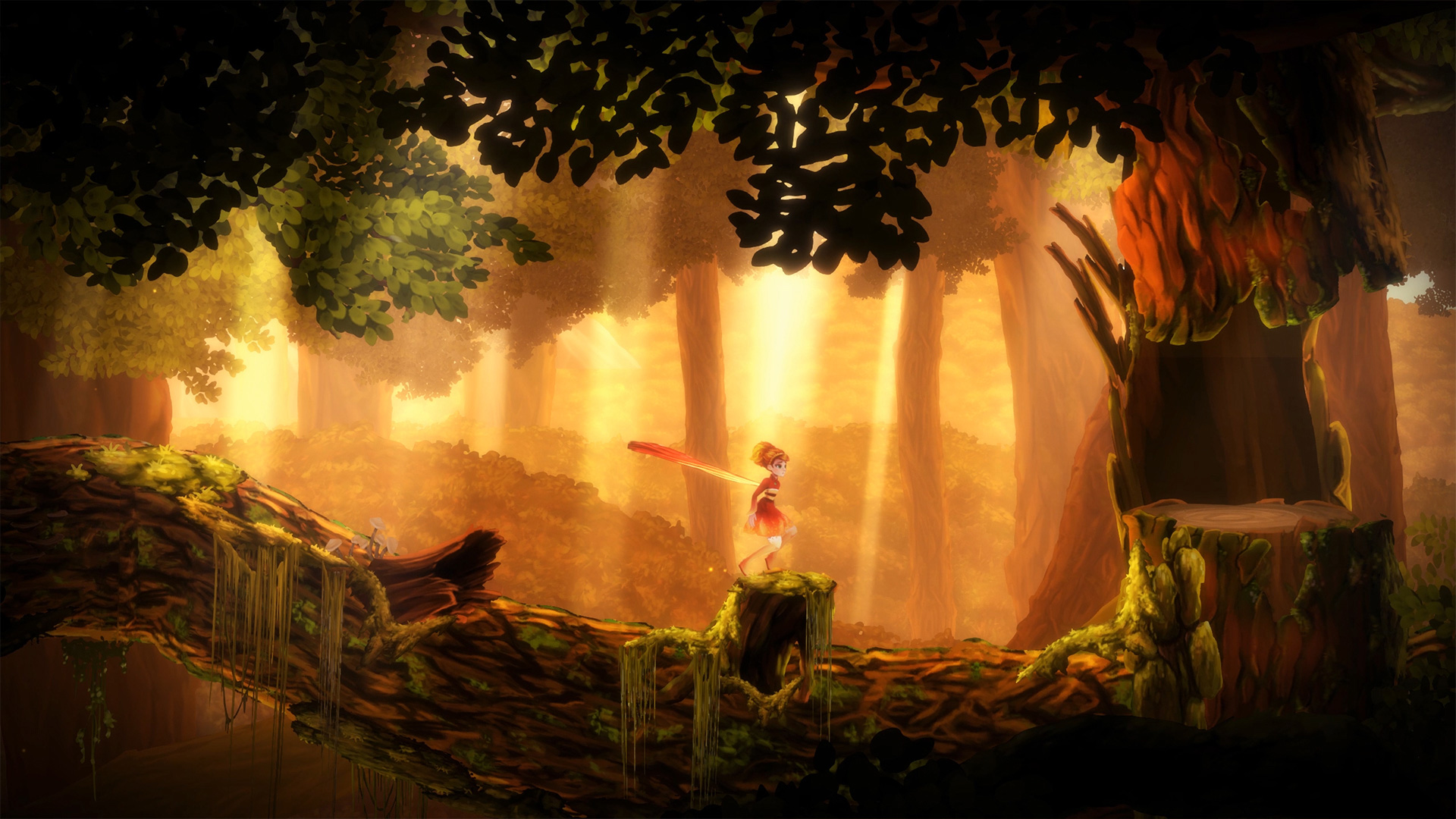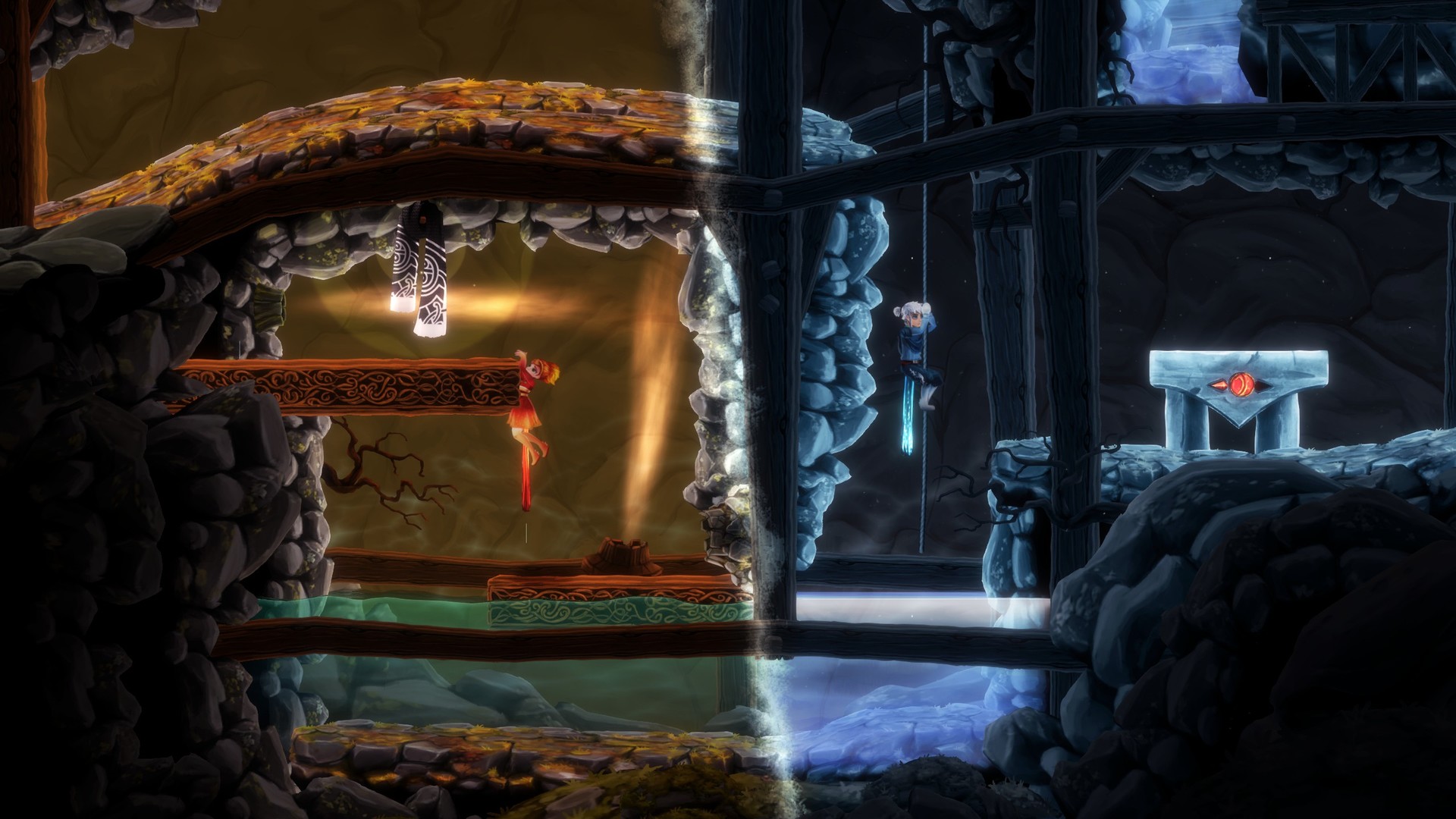Degrees of Separation is a co-operative game that centers around the concept of opposites and how harmony can only be achieved through working together, despite your differences. Created by Norwegian developer Moondrop, this side-scrolling puzzle platformer uses the opposing elements of fire and ice to tell a story of love against impossible odds.
The aptly named characters, Ember and Rime, belong to two different realms. Ember’s world is one of warmth and light, while the kingdom Rime inhabits is dark and icy. Each sensing a threat to their kingdoms, they suddenly find themselves brought together by an unknown force.

Tethered by Temperature
As the punny title suggests, our two heroes are kept eternally separate by a force field that stops their clashing worlds of fire and ice from overlapping. With a divide that results in your screen being split perfectly down the middle, Ember and Rime must combine their unique talents if they have any hope of saving their worlds.
In the game you travel the land, combining Ember and Rime’s powers to collect magical scarves. These scarves have the ability to unlock ancient doors to ever more dangerous areas.
Although dubbed a puzzle platformer, the game is much heavier on the puzzles than the platforming. If you’re a fan of platformers be aware that the mechanics here are fairly basic and mostly entail a bit of jumping and grabbing onto ropes. Figuring out how to get one or both heroes to reach the scarves is much more nuanced and engaging.
The heat and cold powers of Ember and Rime each have specific effects on their environments which they use to navigate around the levels. The warmth of Ember’s world opens heat vents that shoot her to higher levels, while Rime’s icy presence lets him walk across frozen water.
Although separated, you can use the barrier between them to your advantage, as your characters’ movement twists the split screen this way and that. It’s often a balancing act to throw the correct proportions of the world into cold or warmth.
Solving these problems is intuitive at first, but becomes increasingly precise. Puzzles get more and more challenging, to the point that only pinpoint accuracy will suffice.

Not So Harmonious Teamwork
While the game’s decidedly a co-op, you can also play by yourself. If you’re playing alone you’ll have control over both characters, which is harder than it sounds.
Co-op isn’t a walk in the park either. It demands almost unnatural accuracy and will likely have you and your partner yelling at each other in frustration. A far cry from the effortless teamwork of your in-game counterparts.
There are also a few bugs. Some are just annoying, like getting stuck in the scenery, while others are game breaking. No matter how fun a game is, there are only so many times you can be forced to restart and still keep wanting to play.

Embracing the Fantasy Tale
At its heart Degrees of Separation is a fairytale. It uses the familiar broad brush strokes of its genre, like the Quest and the Magical Garment, to craft an enchanting world.
Ember is a fiery being while Rime is a creature of ice. Even as their relationship grows stronger, the tragic truth is that they can never touch. It’s a simple concept that’s more emotionally compelling than you’d think.
The story is written by Chris Avellone (of Fallout: New Vegas and Pillars of Eternity fame), who knows how to capture the story of a epic journey with appropriate gravitas. As you play you really feel like you’re being swept along in a grand tale.
The game isn’t hard on the eyes either. Its airy, painting-like art style perfectly encapsulates its elemental fantasy setting. As you traverse the rich Nordic landscapes, it’s clear a ton of attention has been paid to the intricate details of the different worlds. The vivid oranges, greens, and browns pop alongside stark white and bluish hues. It’s a treat for the eyes to get to see that contrast play out on screen.

Pros
- Fun puzzles
- Engaging story
- Beautiful art style
Cons
- Underdeveloped platforming
- Significant bugs
Conclusion
Degrees of Separation is a charming yarn of love and overcoming differences, with enjoyably tricky puzzles to boot. Its biggest sell is its gorgeous visuals, which more than make up for some uninspired platforming. But for a game that stresses balance, there’s an unevenness between the puzzling and the platforming. This and the bugs aren’t enough to stop the game from being good, but they do keep it from being great.



